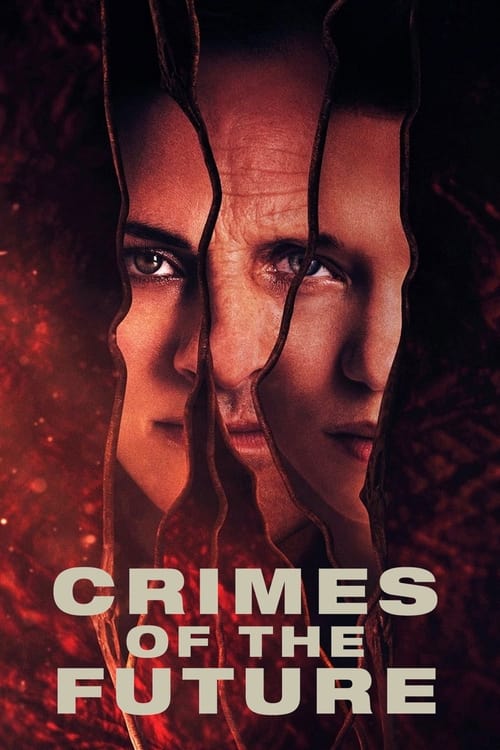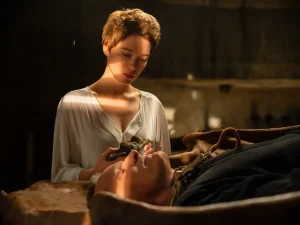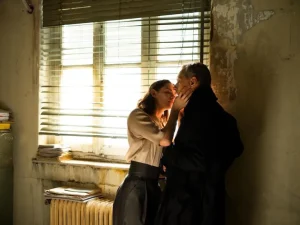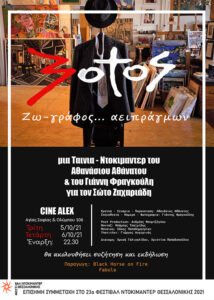CRIME OF THE FUTURE
Σεπ 15, 2024 Κινηματογράφος 0

FILM CRITICS
THE SYMBOLE OF CRIME
Crime of the future: write Giannis Fragoulis
David Cronenberg’s film, “Crimes of the Future” (2022), is a symbolic account of the pleasure and security that a person can experience in the future, not too far from our time. The truth is that it’s a bit difficult to read, but if you pay attention and don’t start aphorisms, in terms of the violence depicted, it’s relatively easy to understand its meanings.
Crime of the future: The story
A small child is playing on the beach. His mother tells him not to eat anything. This one goes and eats the plastic bath basket. His mother freaks out and chokes him. We are transported to another “strange” environment. People are having surgery on their bodies. Their organs are regenerating. A couple does this in their artistic activity. Contact with the eminent scientist, Dr. Nasatir, opens a great window into both their art and their own lives. “Crimes of the Future” is directed by David Cronenberg, co-produced with Greece.
Everything seems strange and relatively horrible. But it’s not. We can see elements of the same director’s films “Crash” (1996), “Naked Lunch” (1991) and “The Fly” (1986). The same title appears in another film by David Cronenberg in 1970, but with a different theme focusing more on love scenes. This production is about a future man who changes his body by following a procedure with some biochemical programs.
Crime of the future: The kies
In “Crimes of the Future” we see a scene where the mother kills her child. We go to another social setting where two former doctors are now artists and perform using their bodies. The procedures they perform are like following an erotic procedure. It’s the new sex. The man is the subject in this erotic operation. He is not good at the old sex, as he confesses to a woman who kisses him on the mouth, obviously in love with him. But what is the new sex?

Every body surgery is like an erotic act. This is the first key point to understand what the film is trying to say. In this way they receive pleasure. At the same time they accept pain as an element related to their dreams. They will, therefore, find pleasure again in their imagination. This process is done in complete safety, although they sometimes improvise. This is the second key point. The bed where the man sleeps is connected to wires that inject hormones into his body. It is shaped like a womb. His body, internally, is constantly changing. Tumors are created that have to come out of his body and they do.
Crime of the future: A another experience
We’ve identified three key points in the “Crimes of the Future”. These have to do with security (the axiom of nirvana in psychology) and pleasure (the axiom of pleasure in psychology), as Freud teaches us. These are basic functions in man when he is in his mother’s womb. There he feels that he is self-empowered, like a god. When he is born he is mortal, he dies little by little every day. The womb-bed helps us to understand that man returns to his mother’s womb, where he feels safe and happy. They do this, in their artistic activity, like a performance art, as Yerzhi Grotowski teaches us. The subtitles mistakenly confuse Performance with performance. So “Crimes of the Future” is about another experience, another way of experiencing our lives.
It is stated that this way of life is dangerous as far as those who rule society are concerned. We can understand that the person who receives pleasure and security can judge and decide about his life in a way that he will find the “right” path to follow. This is often contrary to the one proposed by those in power. This is where Freudian theory meets Epicurus’ philosophy.

Crime of the future: The primary personas
Let’s do a reading of the film again. A key given by the director and writer is that the mother, the child and the father, Dr. Nasatir, were in the same machine, they had undergone the same procedure at the same time, the operators were the pair of artists. This is within his dream, but the dream, as we have said, has a direct and interactive relationship with reality. In “Crimes of the Future” we now see the three main characters who remind us of the primary personas in religious mythologies. In the Christian one they are Joseph, the Virgin Mary and Christ. The latter dies and shows a way of redemption, thus saving the world. All three are in a womb that is none other than Mother Earth, the ancient and great goddess.
The viewer, as a reader of the film text, is free to choose the path that the film’s text extends, since the director leaves us a wide open door. In the end, the artist eats Dr. Nasatir’s food. We don’t know if he will die, like a police agent. We do know that, in this way, he will be self-sufficient, like a fetus, since his food comes from the materials of his body. We come again to the consideration of safety and pleasure, as we said above. The director leaves us free to decide, to make our own meta-text.
Crime of the future: The qualities
In “Crimes of the Future” the actors play realistically, portraying the character in a futuristic environment. Very good are Viggo Mortensen, as Saul Tenser, a performer; Scott Speedman, as Dothrice, a performer; and Yorgos Pirpassopoulos, as Dr. Nasatir. The editing is slow in order to give the viewer time to read the film text and create the characters. The music simply accentuates the scenes. The photography is excellent, purely cinematic, distracting the person from the field behind, conveying the three dimensions and a naturalism that works in contrast to the futurism of the film. The special effects and makeup are excellent, capturing the realism as much as this film needs. Personally, I find it to be a very interesting film.
CRIME OF THE FUTURE
Directed by: David Cronenberg
Wrighting: David Cronenberg
Cinematography by: Douglas Koch
Editing: Christopher Donaldson
Music: Howard Shore
Sound: Roni Abelha, Tom Bjelic, Tasos Selimos
Costume: Mayou Trikerioti
Set decoration: Dimitra Sourlantzi
Make up: Alexandra Anger, Dora Nazou, Monica Pavez, Evi Zafeiropoulou
Special effects: Giorgos Alahouzos, Roulis Alahouzos, Christopher Stratos
Visual effects: Peter Bas, Lauren Galloway, J.P. Giamos, Andy Robinson, Christopher Lee Zammit
Produced by: Dietmar Güntsche, Michael Kölmel, Laura Lanktree, Robert Lantos, Panos Papahadzis, Steve Solomos
Cast: Sotiris Siozos (Brecken), Lihi Kornowski (Djuna), Scott Speedman (Lang Dotrice), Viggo Mortensen (Saul Tenser), Léa Seydoux (Caprice), Don McKellar (Wippet), Kristen Stewart (Timlin), Ephie Kantza (Adrienne Berceau), Yorgos Pirpassopoulos (Dr. Nasatir)
Countries of origin: Canada, Greece, United Kingdom, France
Production year: 2022
Colour: colour, black and white
Language: english
Genre: horror, Sci-Fi, tragedy
Duration: 107΄.
More information about the movie here.
Σχετικά άρθρα
-
 ΕΠΙΣΤΡΟΦΗ ΣΤΗΝ...
ΕΠΙΣΤΡΟΦΗ ΣΤΗΝ...Μαρ 26, 2025 0
-

-
 ΤΕΛΕΥΤΑΙΑ ΠΝΟΗ
ΤΕΛΕΥΤΑΙΑ ΠΝΟΗΦεβ 26, 2025 0
-
 ΘΟΛΟΣ ΒΥΘΟΣ
ΘΟΛΟΣ ΒΥΘΟΣΦεβ 18, 2025 0
Στην ίδια κατηγορία
-
 ΤΑΙΝΙΕΣ ΑΠΟ ΤΙΣ...
ΤΑΙΝΙΕΣ ΑΠΟ ΤΙΣ...Απρ 03, 2025 0
-
 Ο ΓΥΡΟΣ ΤΟΥ ΚΟΣΜΟΥ...
Ο ΓΥΡΟΣ ΤΟΥ ΚΟΣΜΟΥ...Απρ 02, 2025 0
-
 ΜΙΑ ΓΥΝΑΙΚΑ...
ΜΙΑ ΓΥΝΑΙΚΑ...Μαρ 29, 2025 0
-
 ΦΕΣΤΙΒΑΛ ΓΑΛΛΟΦΩΝΟΥ...
ΦΕΣΤΙΒΑΛ ΓΑΛΛΟΦΩΝΟΥ...Μαρ 25, 2025 0
Αναζήτηση
-
 WONDER WOMAN
WONDER WOMANΙούν 09, 2017 138
-
 ΠΑΙΔΙΚΗ ΣΚΗΝΗ
ΠΑΙΔΙΚΗ ΣΚΗΝΗΟκτ 12, 2014 2
-
 ΚΛΗΡΩΣΗ ΠΡΟΣΚΛΗΣΕΩΝ
ΚΛΗΡΩΣΗ ΠΡΟΣΚΛΗΣΕΩΝΜαρ 22, 2014 2
-
 ΔΥΟ ΜΕΡΕΣ, ΜΙΑ ΝΥΧΤΑ
ΔΥΟ ΜΕΡΕΣ, ΜΙΑ ΝΥΧΤΑΝοέ 13, 2014 2
-
 ΑΧΙΛΛΕΑΣ ΨΑΛΤΟΠΟΥΛΟΣ
ΑΧΙΛΛΕΑΣ ΨΑΛΤΟΠΟΥΛΟΣΝοέ 09, 2014 2
-
 ISTABUL FILM FESTIVAL
ISTABUL FILM FESTIVALΜαρ 08, 2014 2
-
 ΤΑΙΝΙΕΣ ΑΠΟ ΤΙΣ ΤΑΙΝΙΟΘΗΚΕΣ
ΤΑΙΝΙΕΣ ΑΠΟ ΤΙΣ ΤΑΙΝΙΟΘΗΚΕΣΑπρ 03, 2025 0
-
 Ο ΓΥΡΟΣ ΤΟΥ ΚΟΣΜΟΥ ΤΟΥ ΜΙΚΡΟΥ ΓΚΡΙΖΛΙ
Ο ΓΥΡΟΣ ΤΟΥ ΚΟΣΜΟΥ ΤΟΥ ΜΙΚΡΟΥ ΓΚΡΙΖΛΙΑπρ 02, 2025 0
-
 ΗΛΙΟΣ ΜΕ ΔΟΝΤΙΑ
ΗΛΙΟΣ ΜΕ ΔΟΝΤΙΑΑπρ 02, 2025 0
-
 ΠΑΓΚΟΣΜΙΑ ΗΜΕΡΑ ΘΕΑΤΡΟΥ
ΠΑΓΚΟΣΜΙΑ ΗΜΕΡΑ ΘΕΑΤΡΟΥΜαρ 29, 2025 0
-
 ΜΙΑ ΓΥΝΑΙΚΑ ΕΞΟΜΟΛΟΓΕΙΤΑΙ
ΜΙΑ ΓΥΝΑΙΚΑ ΕΞΟΜΟΛΟΓΕΙΤΑΙΜαρ 29, 2025 0
-
 ΕΠΙΣΤΡΟΦΗ ΣΤΗΝ ΠΑΤΡΙΔΑ
ΕΠΙΣΤΡΟΦΗ ΣΤΗΝ ΠΑΤΡΙΔΑΜαρ 26, 2025 0

Δείτε το τρέιλερ της ταινίας μας, που συμμετέχει το Φεστιβάλ Ντοκιμαντέρ Θεσσαλονίκης.
SOTOS, EVERLASTING PAINTER (TRAILER)
Youtube
Επικοινωνήστε
ΓΙΑΝΝΗΣ ΦΡΑΓΚΟΥΛΗΣ
Email: info@filmandtheater.gr
Τηλ: (+30) 6974123481
Διεύθυνση: Ιωαννίνων 2, 56430, Σταυρούπολη Θεσσαλονίκη
![]()

